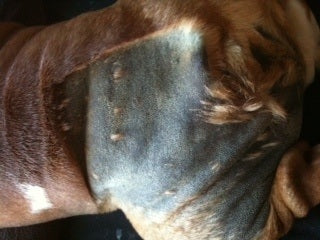Black Skin Disease
Click here to see their full stories on our blog
-
Chica before DERMagic with black skin
-
Chica a few months into DERMagic
-

Chica after finishing DERMagic
-
Cherie before DERMagic.
-

Cherie after using the DERMagic system
-

Gunner's hair did not regrow after a vet visit
-

Gunner's hair regrowing while using DERMagic
-

Striker day one of DERMagic
-

Striker after using DERMagic
Does your dog suffer Black Skin Disease (Alopecia X)?
The term Alopecia is nothing more mysterious than the medical word for hair loss, originally from the Latin via Greek Alopekia, meaning fox mange. The disease itself, also known as Black Skin Disease, is little understood. This condition in animals is called Alopecia X because the cause(s) of this condition are still relatively unknown and the treatments tend to be by trial and error (or, as some would suggest, random). This disease can be easily confused with "Cushing's Disease."
The disease manifests initially as thinning hair, sometimes accompanied by itchy skin and sometimes not, followed by bald patches, followed by blackened or dark gray skin. Eventually, the dog can become completely bald with deep charcoal-gray skin. Often, the dog will smell really bad.
The dogs above were suffering Alopecia X. For many dogs with this disease, there appear to be no other symptoms, and the disease can be regarded as cosmetic. This is actually the approach many vets will take, suggesting that the dog wear a sweater to prevent getting a chill. The disease could be genetic, however, or rather, the tendency or susceptibility to contracting this disease may be part of the dog's genetic makeup. And it is true that some breeds seem more prone to Black Skin Disease than others, with Pomeranians leading the pack.
Black Skin Disease can manifest in other ways and other places also, often beginning on the belly and inside the back legs, as shown on the right. Generally, this type of disease is associated with overall itchiness and skin eruptions. A bad odor might be present, causing the owner to bathe the dog more and more frequently, making the disease worse and the dog even itchier. When itching is present, veterinarians will often prescribe steroids (cortisone or prednisone) to reduce the inflammation. Please note that we never recommend steroids, as they disrupt the dog's natural immune system and the disease will become worse. Further, the use of steroids will encourage mange mites and bacteria to move in, with grave results.
A very early stage of this type of Black Skin Disease is shown at right, where only small black or rusty-colored dots pepper the skin, usually on the belly and especially around the genitals and teats. However, these specks are an early indicator of a very serious attack on your dog by some infecting agent, whether it's a fungus (or yeast), bacterium, or follicular mite. It will not go away or get better with time, and is usually accompanied by mild, occasional itching. A single flea bite can give rise to this situation, that nasty flea injecting who knows what kind of pathogen just under your pets skin.
So how do I fix this problem? It's simple just use the The DERMagic System! Just follow the instructions, take lots of before, during and after photos, and keep us posted on how things progress. Remember that patience and persistence are the keys to success!




